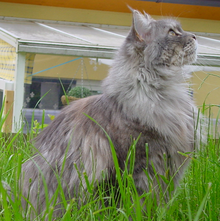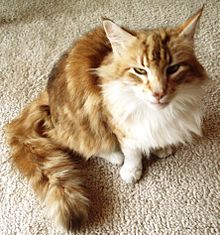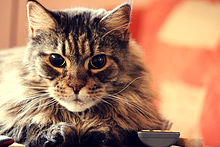Maine Coon cat
| Maine Coon | |||
|---|---|---|---|
|
|||
| Origin: | Northeast United States of America | ||
| Fur length: | Semi-longhair cat | ||
| Weight: | Male: 5.5–9.0 kg. Cat: 4.0–6.5 kg |
||
| generally recognized colors: | Epistatic white, black ( brown in US parlance), blue, red, cream, each with or without silver and with or without spotted white | ||
| not generally recognized colors: | Chocolate, Cinnamon, Amber (and their dilutions) and Golden | ||
| permitted coat pattern: | all fur drawings except Point | ||
| Breeding standards: |
|
||
| List of cat breeds | |||
The Maine Coon cat ( English coon from raccoon "raccoon"), also called American forest cat , is an originally American domestic and utility cat ( English : working cat ) from the northeast of the United States , which in 1985 from the US -amerikanischen State of Maine to the "State cat" ( state cat ) was appointed. It has been bred systematically for a long time. It is a semi-longhair cat of medium weight. Since they are very affectionate, the Maine Coon is also called dog cats . Other names of the breed are Maine Cat or Maine Shag . Because of its nature and size, it is also referred to as the gentle giant ("gentle giant"). Colloquially , Maine Coon cats are sometimes affectionately called "Coonies". Together with the Norwegian forest cat and the Siberian cat, it belongs to the group of so-called forest cats, which in turn belong to the natural breeds .
Appearance
The cat is large-framed and has a long, bushy tail. The head is slightly longer than it is wide, the muzzle is wide, and the eyes are set wide apart. The ears are large and broad at the base; small lynx brushes are welcome, but not a must. Ear tufts protect the ears from the cold. The cat has long, thick and water-repellent fur. Tufts of fur, the "snowshoes", protrude from between the toes. A Maine Coon is only fully grown when it is around three years old. Along with the Norwegian Forest Cat and the Ragdoll (according to the official breed description), it is one of the largest and heaviest domestic cats. A fully grown tomcat can grow from nose to tail tip over four feet long and over twelve kilograms (which is rather the exception).
Behavior and characteristics
As the original working cat, the Maine Coon is a gifted hunter; they are also generally intelligent and playful animals. They prefer to use their paws, which means that they can easily open doors, taps, and pick up small objects. Maine Coons are also skilled " retrievers ". Many Maine Coons ingest their food with their paws and do not eat straight from the food bowl. They are also very often extremely water-loving and like to play with them. Their voice is rather soft and very high, which actually does not fit the size of the animals. The Maine Coon is very talkative with both humans and their fellows. Despite the soft "cooing" voice, she can point out your wishes very specifically and very clearly. Often Maine Coons are very “socially” cats. If they live with other pets, not just cats, they are often tolerated by them. Your dealings with people can be described as extremely friendly and affectionate. Aggressive behavior by Maine Coons is very rare, even towards young children.
origin of the name
As mentioned below, the name should Coon on the similarity to the raccoon (Engl. Racoon ) be due. This similarity does not only refer to the external appearance, but also to the affinity for the element water. Maine Coons are not afraid of water and often play with it. They also often dip their food in water.
Legends and assumptions about the origin
Various stories and myths surround the origin of the Maine Coon .
The appearance of the early Maine cats, especially the bushy tail, strongly reminded the inhabitants of the New England states of a raccoon (English coon or racoon ). This gave rise to the myth that the Maine Coon is said to have emerged from the mating of a cat with a raccoon, which is biologically impossible.
Another story is about a Captain Coon who traveled to New England as a trade captain . When the captain disembarked, his long-haired ship's cats followed him , and while he traded his cats mated with the harbor cats. And when after nine weeks a long-haired cat was somewhere in a litter again, the comment was: "Another Coon cat!"
A third theory is that they came from crossing long haired cats of French Queen Marie Antoinette (who is known to have loved long haired and fluffy animals and who indeed got a lot of private things on a ship to America / Maine) with native cats have arisen.
A fourth legend assumes that the Maine Coon cats are descendants of the Norwegian Forest Cats, who came to New England around the year 1000 AD with the Viking Leif Eriksson as ship cats and reproduced there. Indeed, the forest cat races are all relatively similar.
Other authors suggest that the Maine Coon was created by natural selection due to the very cold, harsh winters in New England, in which only the strongest, largest, and most adapted cats could survive.
This is countered by the fact that such evolutionary adjustments require significantly longer periods of time. The first evidence of long-haired cats of the Maine Coon type is only documented in the second half of the 19th century. The United States is an immigrant country. Virtually every ship had cats on board to fight rats, and better-off immigrants will also have brought their pets with them. It is very likely that this is how the longhair gene in cats came to the United States.
America's first show cat
Maine cats were very popular as early as the middle of the 19th century. At agricultural fairs like the Skowhegan Fair , the most beautiful Maine cat was chosen, which was then allowed to carry the title Maine State Champion Cat . Mrs. E. R. Pierce, who was the co-owner of a black and white Maine male named Captain Jenks of the Horse Marines , documented the early history of the domestic cat in the States, including the Maine Coon. The Maine Cats , as they were then called, appeared on shows in the areas west of Chicago as early as 1870. The great cat fancy fever began around 1900 . Cat shows have been organized all over the United States. In 1906 cat lovers founded the Cat Fanciers' Association (CFA), which is now represented worldwide. In the first stud book of the CFA 28 Maine cats were registered, e.g. B. Number 5, Molly Bond.
History of breeding
After the early boom, the breed was quiet until the early 1950s, and it fell into disuse. In order for the Maine Coon to be recognized as a pedigree cat again, lovers and breeders began with a show-in , i. H. Maine Coons were featured at every cat show. Since no “breeding cats” of the breed were available at this point in time, so-called foundation animals, cats fetched from the natural population with the desired characteristics typical of the breed, were used as the basis. The first breeders that are still known today established themselves in the late 1960s to early 1970s. In May 1976, the CFA - ironically the association in which they were first exhibited - recognized the Maine Coon as the last major American governing body to be a fully-fledged pedigree cat. The recognition in the Fédération Internationale Féline d'Europe (FIFé) did not succeed immediately. It was only in 1983 that FIFé added the Maine Coon to the list of pedigree cats.
Even before the Maine Coon was recognized by the breeders' associations, the Maine Coon Breeders & Fanciers Association (MCBFA) was founded in America in 1968 for the purpose of recognition as a "pedigree cat" , which is probably the most important international Maine Coon-specific association to this day. These breed-specific groupings also exist in Italy, the Netherlands and Finland, other European strongholds of Maine Coon breeding besides Germany. In Germany itself there has not been such an association since the beginning of the 21st century, but until 2002 the IG Maine Coon of the 1st German Noble Cat Breeders Association (1st DEKZV) was decisive for the success of the Maine Coon as the most frequently kept pedigree cat . which was also causally responsible for the current FIFé standard.
Since diseases have not been absent in Maine Coon breeding, breeders are trying, with variable success, to expand the gene pool again by resorting to today's Foundation animals. By crossing animals with an unknown background, not only does the gene pool expand, but also the possibilities of obtaining undesired properties, optics or diseases as results.
Top 5 and clones
From the three best-known initial lines, the animals named as Top 5 emerged, which are not missing in any family tree of a "classic" Maine Coon. It is estimated that these top 5 are represented in the pedigree of a Maine Coon raised without New Foundations with the following percentages :
- 70% ... top 5 cats
- 55% ... top 3 cats
- 40% ... top 2 cats
The descendants of Heidi Ho Sonkey Bill, born in 1978, with Tanstaafl Polly Adeline are known as clones because they looked extremely similar. Due to the excellent exhibition quality of these cats, they were repeatedly used in breeding and contributed significantly to the gene pool of the modern Maine Coon. By and large, the clones make up 35% of the family tree of a Maine Coon raised without New Foundations .
Polydactyly in Maine Coons
At the beginning of the planned breeding of the Maine Coon, the gene pool consisted of approx. 40% polydactyl (many-toed) animals. However, since it was difficult to introduce a “farm cat” as a “pedigree cat” to the American umbrella organizations, it was decided to postpone the recognition of this variant to a later date. To this day, this variant is permitted for breeding (not in Germany due to § 11b TSchG ), but it is not allowed to compete for the coveted title at shows.
default
Depending on the breeder's association, the standards of the international breeders' association to which his association is affiliated apply. These standards of the CFA, FIFé, The International Cat Association (TICA) or World Cat Federation (WCF) differ only minimally from each other. A fundamental work on the standard is the Maine Coon seminar , which was created by an international pedigree cat judge and long-time Maine Coon breeder.
health
In the course of breeding the Maine Coon, the presence of various hereditary diseases of cats and, in particular, of breed typical diseases has emerged, some of which have now been well researched. Mainly these are:
Hypertrophic cardiomyopathy
An animal with hypertrophic cardiomyopathy (HCM) appears externally healthy. However, it is likely to die of sudden cardiac death at an unpredictable time . HCM can be stopped with medication with good success, but usually cannot be remedied. Regular heart examinations - about every 1–2 years - by ultrasound for a reliable clarification are the optimum here.
Hip dysplasia , elbow dysplasia , and patellar dislocation
In fast-growing, large, heavy breeds, complications in the joints can occur during the growth phase. They are diagnosed using x-rays of the hips and joints. Since specific hip dysplasia x-rays are often not performed by veterinarians, a specialist in orthopedics should be consulted. Surgical help is possible, but not always necessary for cats.
Spinal muscular atrophy
The spinal muscular atrophy (SMA) is a motor neuron disease d. H. a disease of the nerve cells. It causes symptoms of paralysis. The status of the SMA can be clearly established by means of a genetic test and can be bred specifically with this information; in this way, animals affected by SMA can be avoided.
Kidney disease
The polycystic kidney disease (PKD) must be distinguished from renal cysts (Cystic Renal Disease). In both cases, cysts develop in the kidneys, but only in PKD the function of the kidneys becomes more and more restricted as the cysts grow. The course of PKD can be adjusted with medication, but ultimately fatal. A genetic test for Persian cats and Persian descendants, which is not validated for Maine Coon, is available. A regular ultrasound of the kidneys is still the best way to look for potential problems. In an 8-year-old study published in 2013 with participating Maine Coons from Switzerland, Germany and other Northern European countries, it was found that there are individual cysts in young animals (in 7 of 187), but they are neither PKD nor with PKD1- Genetic test can be detected. Chronic kidney disease (CKD) was found in 10 of the animals tested, but this again has nothing to do with cysts.
literature
German
- Elke Carson, Monika Wegler: Maine Coon . Gräfe & Unzer, 1998, ISBN 3-7742-3145-1 .
- Eva-Maria Götz, Gesine Wolf: Maine Coon & Co. Semi-long-haired cats . Eugen Ulmer, 2006, ISBN 3-8001-4843-9 .
- Dominik Kieselbach, Angelika Kneifel: Maine Coon, your hobby . Bede, 2003, ISBN 3-89860-038-6 .
- Kerstin Malcus: Maine Coon: Wild shell, soft core . Cadmos, 2008, ISBN 978-3-86127-134-5 .
English
- Carol Himsel, DVM Daly, Karen Leigh Davis: Maine Coon Cats (Complete Pet Owner's Manual) . Barron's Educational Series, 2006, ISBN 0-7641-3402-7 .
- Marilis Hornidge: That Yankee Cat. The Maine Coon . Tilbury House Publishers, 2002, ISBN 0-88448-243-X .
- Abigail Greene: Guide to Owning a Maine Coon Cat . TFH Publications, 1997, ISBN 0-7938-2166-5 .
- Sharon Bass: This Is the Maine Coon Cat . TFH Publications, 1996, ISBN 0-86622-096-8 .
Web links
- MCBFA
- Maine Coon Aid (aid organization for needy Maine Coons)
Individual evidence
- ↑ 1 §217. State cat. (PDF) Retrieved October 25, 2008 (English).
- ^ Rene Bache: Raising Cats . In: The Saturday Evening Post . January 19, 1901, p. 15 .
- ↑ Bruce Roberts: Coon Cats . In: Portland Evening Express . 2nd July 1986.
- ^ Maine Writers Research Club: Maine, My State . The Journal printshop, 1919, p. 221 .
- ↑ I. Archtander Nystad: Norwegian Forest Cat and Maine Coon - a cat breed? In: Waldkatzen Magazin . January 1989.
- ↑ a b c Marilis Hornidge: That Yankee Cat. The Maine Coon . Tilbury House Publishers, Gardiner 2002, ISBN 0-88448-243-X , pp. 1-9 / 28 .
- ↑ The Maine Coon: Cat Breed FAQ. In: Cat Fanciers Web Site. Retrieved October 25, 2008 (eng).
- ↑ maine-coon.org
- ↑ a b c d Kerstin Malcus: Maine Coon: Wild shell, soft core . Cadmos, 2008, ISBN 978-3-86127-134-5 , pp. 14th ff .
- ^ IG Maine Coon: Standard Questions . 2nd Edition. Bogel, 1996.
- ↑ HCM - hypertrophic cardiomyopathy in the interest group Herzgesunde Katzen e. V., accessed October 17, 2012.
- ↑ Schinner et al .: Genetic association of the A31P and A74T polymorphisms with feline hypertrophic cardiomyopathy in the Maine Coon . Munich February 2, 2008 (16th annual meeting of the Department of Internal Medicine and Clinical Laboratory Diagnostics of the DVG).
- ↑ Hip dysplasia in cats (HD). In: PawPeds. Retrieved October 25, 2008 .
- ↑ JC Fyfe et al .: An approximately 140-kb deletion associated with feline spinal muscular atrophy implies an essential LIX1 function for motor neuron survival . In: Genome Res. September 2006.
- ↑ http://www.laboklin.de/index.php?link=labogen/pages/html/de/erbkrankheiten/katze/katze_polyzystische_nieren Krankung-pkd.html | Laboklin page with PKD. Maine Coon not listed among the breeds.
- ^ Kraft / Dürr: Cat diseases. Clinic and Therapy . Schaper M. & H., ISBN 3-7944-0178-6 , pp. 907 f .
- ↑ K. Gendron, M. Owczarek-Lipska, J. Lang, T. Leeb: Maine Coon renal screening: ultrasonographical characterization and preliminary genetic analysis for common genes in cats with renal cysts. In: Journal of feline medicine and surgery. Volume 15, Number 12, December 2013, pp. 1079-1085, doi: 10.1177 / 1098612X13492164 , PMID 23735675 .











